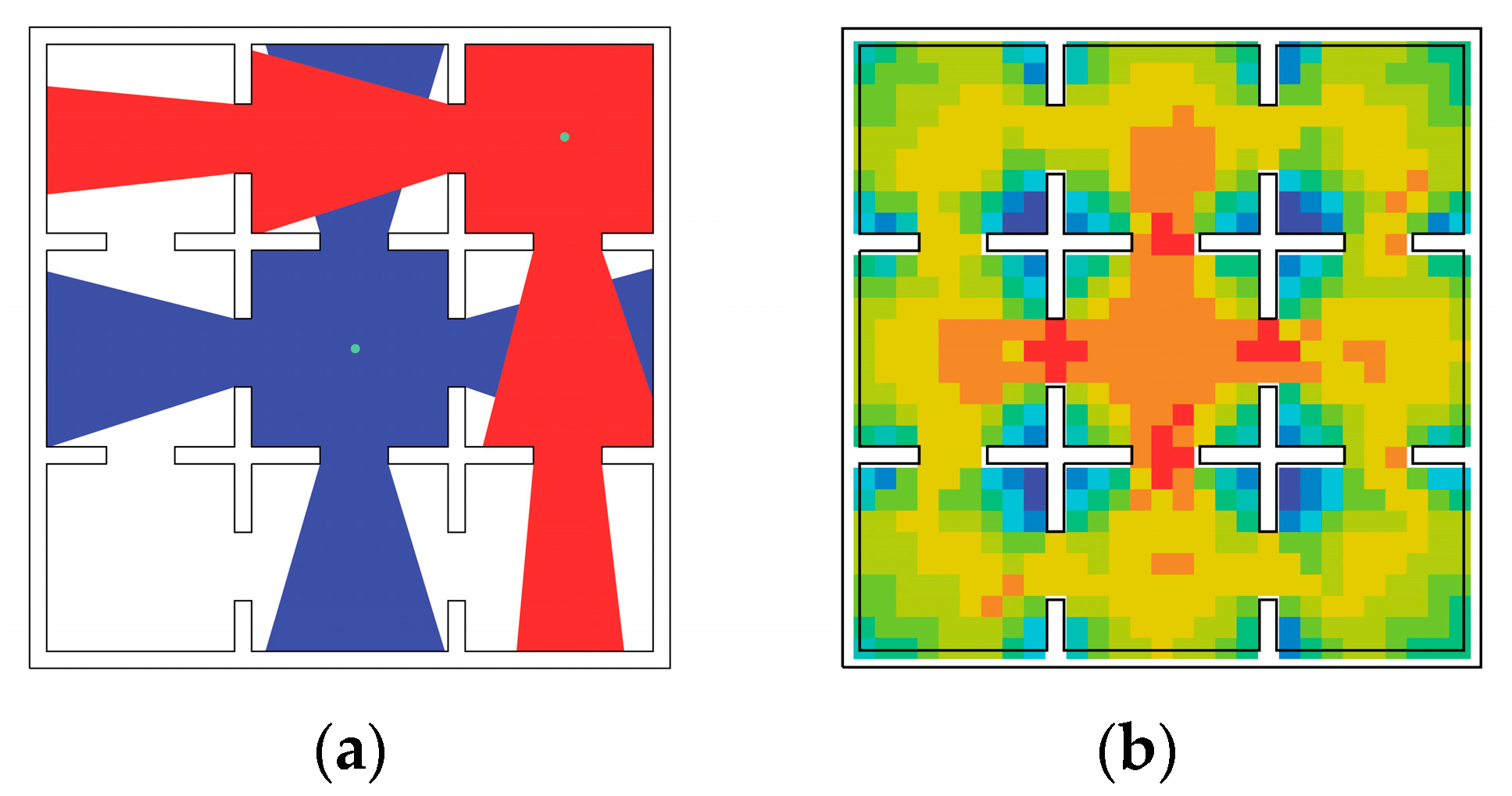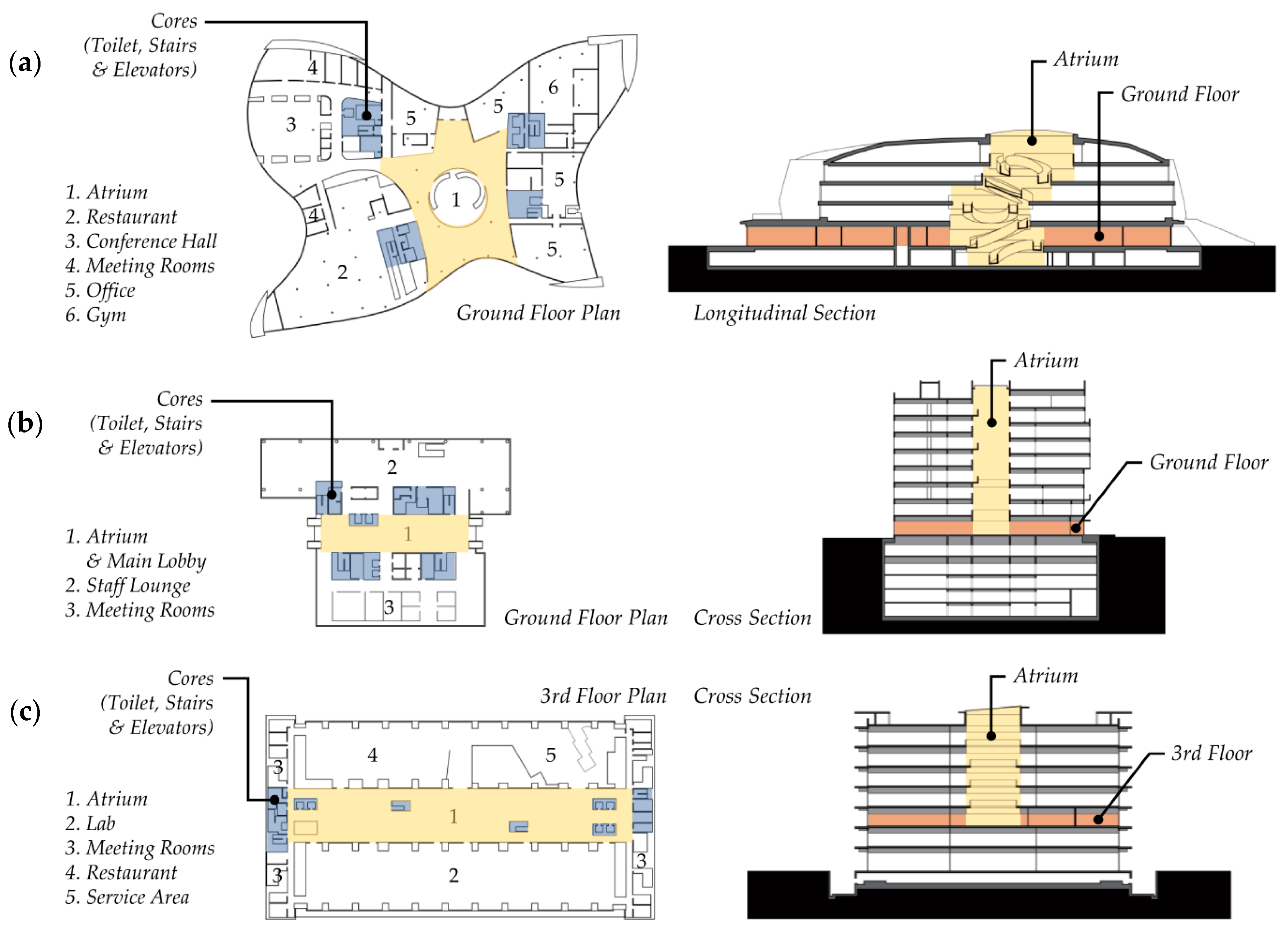Reinterpreting Sustainable Architecture: What Does It Mean Syntactically?
Abstract
1. Introduction: The Problem of Sustainable Architecture
2. Sustainable Architecture
3. Configurations and Space Syntax
3.1. Configurational Approach in Understanding Built Forms
3.2. Space Syntax
3.3. Partitioning Theory: Gaining or Losing Total Depths
3.3.1. Principle of Centrality
3.3.2. Principle of Extension
3.3.3. Principle of Continuity
3.3.4. Principle of Linearity
3.3.5. Losing Total Depths
4. Research Methodology and Cases
4.1. Research Methodology
4.2. Cases
5. Syntactical Analyses and Discussion
5.1. VGAs: Visual Connectivity, Integration, Mean Depth, and Step Depth
5.2. Intelligibility (or Understandability)
6. Conclusions and Future Studies
Funding
Acknowledgments
Conflicts of Interest
References
- Dursun, P.; Saglamer, G. Spatial analysis of different home environments in the city of Trabzon, Turkey. In Proceedings of the 4th International Space Syntax Symposium, London, UK, 17–19 June 2003; pp. 54.1–54.18. [Google Scholar]
- Hillier, B.; Hanson, J. The Social Logic of Space, 1st ed.; Cambridge University Press: Cambridge, UK, 1984. [Google Scholar]
- Guy, S.; Farmer, G. Reinterpreting sustainable architecture: The place of technology. JAE 2001, 54, 140–148. [Google Scholar] [CrossRef]
- Guy, S.; Moore, S.A. Introduction: The paradoxes of sustainable architecture. In Sustainable Architecture: Cultures and Natures in Europe and North America; Guy, A., Moore, S.A., Eds.; Spon Press: New York, NY, USA, 2005; pp. 1–12. [Google Scholar]
- World Summit on Sustainable Development. Available online: https://www.who.int/wssd/en/ (accessed on 27 February 2020).
- Vallero, D.; Brasier, C. Sustainable Design: The Science of Sustainability and Green Engineering, 1st ed.; John Wiley & Sons, Inc.: Hoboken, NJ, USA, 2008. [Google Scholar]
- Hillier, B.; Hanson, J.; Graham, H. Ideas are in things: An application of the space syntax method to discovering house genotypes. Environ. Plan. B Plan. Design 1987, 14, 363–385. [Google Scholar] [CrossRef]
- Hillier, B. Space is the Machine: A Configurational Theory of Architecture; Space Syntax: London, UK, 2007; Available online: https://spaceisthemachine.com/ (accessed on 10 August 2020).
- Van Nes, A. Configurations and urban sustainability. In The Sustainable City III: Urban Regeneration and Sustainability; Marchettini, N., Brebbia, C.A., Tiezzi, E., Wadhwa, L.C., Eds.; WIT Press: Southampton, UK, 2004; pp. 411–420. [Google Scholar]
- Lee, J.H. The Impact of Maps on Spatial Experience in Museum Architecture. Ph.D. Thesis, UCL, London, UK, 2014. [Google Scholar]
- Benedikt, M. To take hold of space: Isovists and isovist fields. Environ. Plan. B 1979, 6, 47–65. [Google Scholar] [CrossRef]
- Hillier, B. The Art of Place and the Science of Space. World Archit. 2005, 185, 96–102. Available online: https://discovery.ucl.ac.uk/id/eprint/1678/ (accessed on 10 August 2020).
- Hillier, B.; Penn, A. Visible College: Structure and randomness in the place of discovery. Sci. Context 1991, 4, 23–49. [Google Scholar] [CrossRef]
- Turner, A.; Doxa, M.; O’Sullivan, D.; Penn, A. From isovists to visibility graphs: A methodology for the analysis of architectural space. Environ. Plan. B Plan. Des. 1987, 28, 103–121. [Google Scholar] [CrossRef]
- Turner, A. Depthmap 4: A Researcher’s Handbook; Bartlett School of Graduate Studies, University College London: London, UK, 2004; Available online: https://discovery.ucl.ac.uk/id/eprint/2651/ (accessed on 10 August 2020).
- Case Study: Olympic House. Available online: https://www.usgbc.org/education/sessions/case-study-olympic-house-12538375 (accessed on 13 March 2020).
- Park, K. 2011 Korean Architecture Award: SK Chemicals’ Eco Lab. Archiworld Vol. 199, 30 November 2011; 100–105. [Google Scholar]
- Epson Innovation Center. Available online: http://www.ibec.or.jp/jsbd/Q/index.htm (accessed on 13 March 2020).
- Lee, J.H. Identifying spatial meanings of atria in built environment and how they work. J. Asian Archit. Build. Eng. 2019, 18, 247–261. [Google Scholar] [CrossRef]







| Cases | Main Features |
|---|---|
| Olympic House |
|
| The SK Chemicals R & D Center |
|
| The Epson Innovation Center |
|
© 2020 by the author. Licensee MDPI, Basel, Switzerland. This article is an open access article distributed under the terms and conditions of the Creative Commons Attribution (CC BY) license (http://creativecommons.org/licenses/by/4.0/).
Share and Cite
Lee, J.H. Reinterpreting Sustainable Architecture: What Does It Mean Syntactically? Sustainability 2020, 12, 6566. https://doi.org/10.3390/su12166566
Lee JH. Reinterpreting Sustainable Architecture: What Does It Mean Syntactically? Sustainability. 2020; 12(16):6566. https://doi.org/10.3390/su12166566
Chicago/Turabian StyleLee, Jae Hong. 2020. "Reinterpreting Sustainable Architecture: What Does It Mean Syntactically?" Sustainability 12, no. 16: 6566. https://doi.org/10.3390/su12166566
APA StyleLee, J. H. (2020). Reinterpreting Sustainable Architecture: What Does It Mean Syntactically? Sustainability, 12(16), 6566. https://doi.org/10.3390/su12166566





